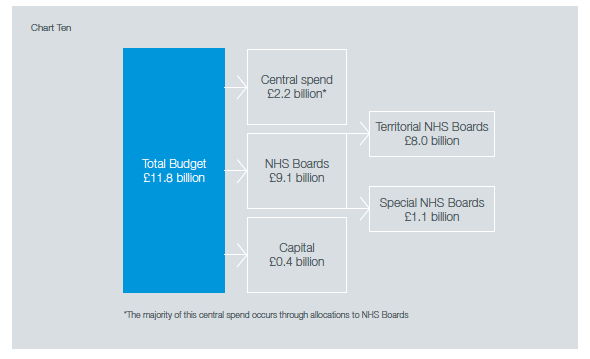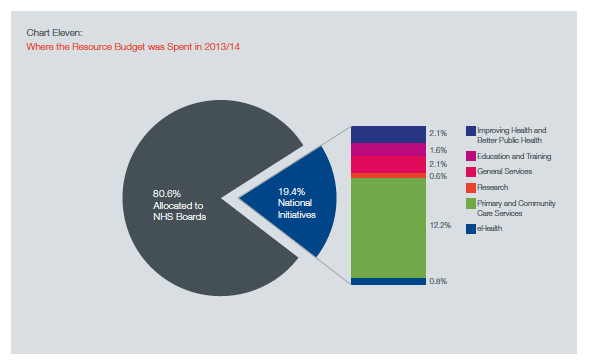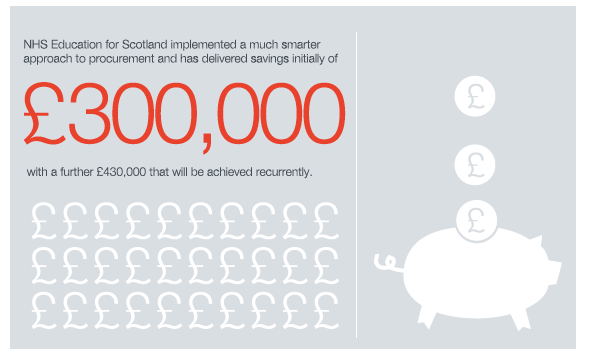NHSScotland Chief Executive's Annual Report 2013/14
The NHSScotland Chief Executive's Annual Report 2013/14 presents an assessment of the performance of NHSScotland in 2013/14 and describes key achievements and outcomes.
Chapter 5 Securing Value and Financial Sustainability
Serving up efficiency and quality - a new catering information system for Fife and beyond.
"It's great to know that the money we're saving is going back into patient care."
Saffron Moir, Assistant Catering Manager, NHS Fife.
Saffron's Story
Soft facilities like catering, cleaning and laundry are major expenditures for every hospital, and their quality can have a significant influence on the patient experience. So any improvement in their management can have a big impact on overall performance.
As part of an ongoing strategic review across NHSScotland, a new Catering Information System has been developed and tested at Queen Margaret Hospital in Dunfermline. A bespoke software application, produced and owned by NHSScotland and NHS Health Facilities Scotland, now covers stock, meal production numbers, purchase data, labour costs and wastage. The system also helps manage non-patient retail catering to review margins and profitability.
"The key improvement is that we now know exactly where we are, from day to day and even hour to hour."
The new system means the team can see the big picture, all the time. Where previously they may have relied on guesswork, they're now equipped with the precise numbers they need to review all aspects of performance on a daily basis.
"There was some resistance from staff at first, as they'd been doing it 'their' way for a long time. But when they realised that the savings were enough to pay the salaries of two full-time cooks, they soon got on board."
Getting used to the new software was straightforward - it was implemented in less than a week - and although there was a little resistance from staff at first, the clear benefits of saving time on storekeeping and clerical work were obvious. With accurate information available in the kitchen itself, cooks have even begun to compete for 'spot-on', waste-free production.
Over the first year, savings have amounted to £40,000 on an investment of £10,400 - roughly a four to one return. That's made up of a reduction in wastage from about 30 per cent to under eight per cent, an increase in retail profit margin, better demand accuracy, and release of resources.
Following success in Fife the pilot has been extended to NHS Borders, NHS Lanarkshire, NHS Tayside, NHS Shetland and NHS Orkney. Now the Catering Information System is being migrated to a web-based platform, which will provide yet more flexibility, accuracy and efficiency in years to come.
"The old attitude of 'it was 200 beef stews last week, so we'll have 200 beef stews this week' has gone. We're responding to patient choice and preference, and providing more choice with less waste." Saffron Moir, Assistant Catering Manager, NHS Fife.

For the sixth year in a row, all NHS Boards have met their financial targets. This means that they have stayed within the budgets allocated to them. This serves to demonstrate the robust financial planning and management undertaken by NHS Boards and the Scottish Government Health and Social Care Directorates.
For 2013/14, health recorded an underspend of £4 million on an overall budget of £11.8 billion which demonstrates that the totality of the budget was used to provide services and invest in infrastructure, thus securing good value in the use of public funds.
In 2013/14, of the total £11.8 billion health budget, the majority of this budget - £9.1 billion - was distributed to NHS Boards at the start of the year. A further £0.4 billion was spent on infrastructure, while the remaining £2.2 billion was directed towards priority areas (in the main through allocations to NHS Boards). Chart Ten shows how both resource and capital funds are distributed and spent.
CAPITAL
The following infrastructure investment took place in 2013/14:
- £230 million of investment as part of the progression of the £842 million New South Glasgow Hospitals Project, which continues on time and on budget and is due to open in the summer of 2015; and
- Completion of the £23 million Aberdeen Health and Care Village, the first hub project to be delivered through the Scottish Government's innovative pipeline of revenue-financed major acute and community health infrastructure. Total investment delivered through the Non Profit Distributing (NPD) and hub programmes during 2013/14 was an estimated £32 million.
Other completed projects during 2013/14 include community health infrastructure across Scotland, including the Vale Centre for Health and Care in Alexandria, the new Glenwood Health Centre in Glenrothes, the Westerhailes Healthy Living Centre and the new Possilpark Health Centre.
RESOURCE
The majority of the resource budget (80.6 per cent) is allocated to NHS Boards and forms their baseline budgets. The remaining 19.4 per cent is held centrally to support national initiatives and target specific priorities. Chart Eleven outlines these target areas. The Scottish Government is committed to ensuring that this remaining funding is allocated to NHS Boards as early in the financial year as possible.

EFFICIENCY SAVINGS
In order to continue to secure value for the public and ensure the future sustainability of the NHS in Scotland, NHS Territorial Boards and Special Boards that deliver direct patient care are required to deliver planned savings each year which they retain in order to reinvest in services. Special NHS Boards that do not provide direct patient care return their savings in order that they are recycled into the overall funding available to support patient care. Over the past five years, NHSScotland has successfully reinvested over £1.5 billion of savings - £275 million in 2013/14 alone - allowing NHS Boards to direct this money towards improving the quality of services.
Across Scottish Government health policy, the priority is to deliver improved quality and safer care whilst ensuring that the NHS is sustainable and delivers value for the public purse. Prudent management of scarce resources, avoiding duplication and removing unnecessary and harmful variation across and within areas is the key component of this approach. NHS Boards have made significant progress with both Territorial and Special NHS Boards continuing to deliver financial balance and savings goals while improving the quality of their services.
The Scottish Government offers a wide range of support to NHS Boards in this. In particular, the Quality and Efficiency Support Team (QuEST) delivers 10 specialist, focused programmes across a range of clinical and non-clinical areas including procurement, facilities, whole system patient flow and mental health. Between them, these programmes have supported NHS Boards to test, spread and embed their own innovative good practice as evidenced by almost 200 examples collected to date.
The Scottish Government's approach to improving the efficiency of health services has been set out in its 2020 Framework for Quality, Efficiency and Value[90] which includes many examples of improvement. Saffron's story of the new catering information system for Fife and beyond is one of the many projects in QuEST's Facilities Programme.
Territorial NHS Boards achieve their savings for reinvestment across a wide range of areas including service redesign, prescribing, procurement and facilities management. Boards also deliver programmes leading to gains in productivity, freeing up staff time and resources that enable them to avoid additional costs. While these savings are not as immediately obvious, they are critical to ensuring that resources are managed effectively and the quality of patient outcomes and experience is improved.

NHS Greater Glasgow and Clyde, supported by QuEST, has made significant improvements in its waiting times for Child and Adolescent Mental Health Services. Using tools and techniques that can improve quality and efficiency, they have reduced the longest wait for these services from 113 weeks to less than 26 in three years and are on track to achieve the 18-week target by December 2014[91].
Support services have an important role in the services provided by NHSScotland and many of the initiatives that lead to improved quality and efficiency are in this area. In the procurement of goods and services, NHSScotland has been working hard to ensure that best value is achieved through its purchasing practice. Special NHS Boards often procure services on behalf of the whole of NHSScotland so it is imperative that they are as effective as possible in this area. NHS Education for Scotland implemented a much smarter approach to procurement and has delivered savings initially of £300,000, with a further £430,000 that will be achieved recurrently. The staff involved have also been freed up to carry out their specialised work as they no longer have to manage procurement activity alongside their own roles.
After staffing, prescribing makes up the second largest part of the NHSScotland budget. NHS Boards have been delivering large savings across their drug budgets for many years but there are still efficiencies to be made, many of them flowing from improvements in the quality of prescribing.
Many patients, particularly those who are older, are on multiple drugs, some of them used to counteract the side-effects of other medicines. The Scottish Government published guidance on the management of this issue - known as polypharmacy - in 2013 and a number of NHS Boards have used them to deliver significant improvements in the quality of pharmaceutical care for patients that have also reduced the cost of drugs.
Two patients with complex needs in Fife required specialist treatment that could only be provided outside Scotland with significant associated cost. This was clearly not best for the patients who had to be away from their families and made management of their wellbeing more difficult. By redeveloping some unused estate into a state-of-the-art facility for these two patients, NHS Fife achieved massive improvements in the social and therapeutic quality of life for the patients, while also delivering savings of £320,000 a year to be reinvested in care.
NHS Lothian carried out a review of 602 patients across 24 GP Practices and subsequently made the following changes:
- 659 medicines were stopped (this includes 150 high-risk medicines stopped);
- 169 medicines doses were reduced;
- 26 medicines doses were increased;
- 91 new medicines were started; and
- 166 medicines were switched, for example, to formulary choices and/or safer and more cost effective alternatives.
The average number of medicines per patient before the review was 11.4 and after review was 10.5, a reduction of 0.9 across Lothian.
In total, immediate savings of almost £40,000 and cost avoidance of over £16,000 were achieved[92]. The activity is ongoing with a full cohort of almost 3,000 patients and the projected savings and cost avoidance will reach almost £250,000 a year. More importantly, many patients will be receiving more appropriate and, in many cases, safer drugs than before that will have a major impact on their quality of life.
The NHSScotland estate (buildings and facilities) is one of its biggest assets. As NHS Boards have redeveloped and redesigned their services to provide better quality care, some buildings and facilities have become surplus to requirements. In such cases, plans are required to find innovative uses for them or, where appropriate, building and land may be sold off to provide the best deal for the public purse. Often, by thinking differently about how to use these resources, NHS Boards can develop services that have an enormously beneficial impact on patients and which can also be more cost-effective.
In addition to this, the Scottish Government, along with Chairs and Chief Executives of NHS Boards, have agreed to develop a programme of work under the heading of 'Once for Scotland' to spread and implement good practice more widely across NHSScotland. Where an intervention is proven to meet the 'Quality, Efficiency and Value' test and can deliver significant gains for the service and its users, the programme will support its adoption by NHS Boards across the whole of Scotland.
Contact
There is a problem
Thanks for your feedback